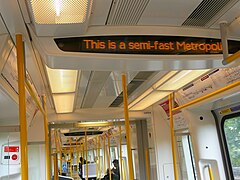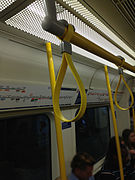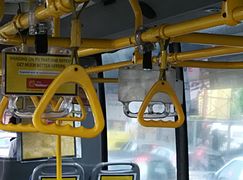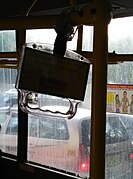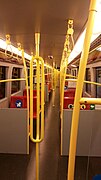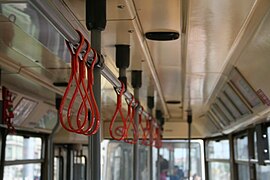Standing passenger


In urban public transport, provision is made for standing passengers, often called straphangers[1][2][3][4] or standees,[5] to rationalize operation and to provide extra capacity during rush hour.
On crowded rapid transit urban lines, while most travelers may be seated during off-peak services, only a limited proportion will be seated during the peak services. The longer the journey, the less willing passengers are to stand. On intercity rail or coach services, the willingness among passengers to stand is often low. It may even be prohibited there or in intercity buses, school buses, gondola lifts, or amusement park railways, with reserved seating to ensure that all passengers can be seated.
In aviation, safety measures require all passengers and crew to be seated with their seat belts fastened during taxiing, take-off, landing, and turbulence, so airlines do not allow passengers to travel without a seat. However, in 2010, Ryanair, a low-cost airline proposed a "vertical seat" design for use by standing passengers on its aircraft.[6]
Seated to standing ratio
[edit]The seated-to-standing ratio is the ratio between the number of passengers that can be seated and the number of standing passengers on a public transport vehicle. A higher standing ratio allows for more passengers in a given area, but detracts the perceived quality of the transport, in particular over long distances.[7] This metric is normally limited to urban mass transit, due to intercity transport normally only offering seated travel. On longer haul services, bilevel cars are often used to allow for increased seating, though this increases the dwell time at stations, making increased seating ratio versus service time tradeoffs.
Passengers per square metre
[edit]Passengers per square metre is a quality of service metric used to determine the standard of comfort provided to standing passengers in a transportation vehicle. Multiplying this number by the total available standing area on a vehicle gives the total standing passenger capacity. Bus services in Europe operate at about four passengers per square metre.[8]
Safety and health
[edit]Standing passengers are susceptible to suffering falls and other injuries, particularly elderly people.[9] Shorter people and children may not be able to reach ceiling-mounted handles, straps, or rails. Porous cloth straps are hard to clean, and are being replaced by rubber or plastic straps, and metal fixtures often made of stainless steel.[citation needed]
Handholds
[edit]Various types of handholds are provided for standing passengers:
- hanging strap – a strap suspended from the ceiling (often with a handle or a loop)
- grab handle – a pivoted, rigidly-mounted, or suspended handle often mounted above eye level of standing passengers
- handrails – rigid rails running horizontally below the ceiling
- stanchions – vertical poles anchored between the floor and ceiling
- grab rails or grab bars – smaller hand rails attached to seats, doors, and doorways
-
An old-fashioned London Underground train with hanging straps without looped handles.
-
Handrails on a modern London Underground S Stock train.
-
Straps inside a London Underground train.
-
R179 car has numerous handholds and looped stanchions for high capacity services in New York City.
-
Grab handles on a commuter bus.
-
Railcar in Buenos Aires eith suspended rings.
-
Moveable straps on a Vienna tram.
-
Strap-hung handles onboard a Seoul Metropolitan Subway railcar.
-
Suspended rings in Indonesia.
-
High-floor coach in South Korea, unusually fitted with grab handles and poles.
References
[edit]- ^ 16 April 1893, Chicago Daily Tribune, pg. 33: "But Lili (a dwarf elephant – ed.) weighs only seventy pounds and her tread would not affect a corn as much as that of the dudish strap-hanger whose equilibrium has been disturbed by the sudden jerk of a green gripman."
- ^ 22 February 1896, Chicago Daily Tribune, pg. 7: "'No sane man,' said a North-sider yesterday who has been a strap-hanger for years, 'expects the street car lines to furnish seats for every passenger during the rush hour morning and evening.'"
- ^ 19 April 1899, New york Times, pg. 6: "When the offer of the Metropolitan Street Railway Company to build the underground railroad was published, the million strap-hangers were silent, inert, and helplessly contemplative."
- ^ "An imposing and formal man, Prescott Bush commuted for years to Grand Central Station, then rode down to Wall Street on the subway. 'He'd die now,' according to George's sister Nancy, 'with limos picking them up. He was a straphanger.'" — Andrew Delbanco, "Self-Remade Man," The New York Times review
- ^ "Standee". Dictionary.com. Retrieved 2015-05-22.
- ^ The Telegraph (London), "Ryanair to sell £5 tickets for standing-room only flights", Laura Roberts, 1 July 2010 (accessed 17 September 2010)
- ^ White, Peter (2002). Public Transport: Its Planning, Management, and Operation. Taylor & Francis. ISBN 0-415-25772-7.
- ^ Bus Systems: An efficient mode of transport - UITP on UITP website, viewed 2013-09-11, which quotes Volvo Bus Corporation as its source
- ^ "Safety of Standing Passengers in Urban Buses" on ScienceDaily website, viewed 2013-09-12


